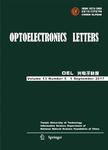Investigation of top-emitting OLEDs using molybdenum oxide as anode buffer layer
Investigation of top-emitting OLEDs using molybdenum oxide as anode buffer layer作者机构:State Key Laboratory of Electronic Thin Films and Integrated DevicesSchool of Optoelectronic InformationUniversity of Electronic Science and Technology of China
出 版 物:《Optoelectronics Letters》 (光电子快报(英文版))
年 卷 期:2012年第8卷第3期
页 面:197-200页
核心收录:
学科分类:0810[工学-信息与通信工程] 08[工学] 081001[工学-通信与信息系统] 0803[工学-光学工程]
基 金:supported by the National Natural Science Foundation of China (No.60425101) the Young Excellence Project of University of Electronic Science and Technology of China (No.UESTC-060206) the Fundamental Research Funds for the Central Universities of China (Nos.ZYGX2010Z004 and ZYGX2009J054)
主 题:Anodes Buffer layers Charge injection Molybdenum oxide Silver
摘 要:A high-effective bottom anode is essential for high-performance top-emitting organic light-emitting devices (OLEDs). In this paper, Ag-based top-emitting OLEDs are investigated. Ag has the highest reflectivity for visible light among all metals, yet its hole-injection properties are not ideal for anodes of top-emitting OLED. The performance of the devices is significantly improved using the molybdenum oxide as anode buffer layer at the surface of Ag. By introducing the molybdenum oxide, the hole injection from Ag anodes into top-emitting OLED is largely enhanced with rather high reflectivity retained.



